Yoga for Sciatica: 10 Poses for a Holistic Approach to Pain Relief
Sciatica is a distressing and painful condition that may interfere with one’s day-to-day life. So, discover how performing yoga for sciatica can help offer relief conveniently.

Sciatica is a painful lower back pain issue that radiates throughout the path where the sciatic nerve runs which includes the hips, and down each leg (1). Practicing yoga for sciatica is a holistic approach to mind-body wellness that offers great benefits to individuals fighting with this condition that involves intense pain. Yoga asanas or poses allow for gentle stretching, enhancing flexibility and alleviating tension around the sciatic nerve. They also help increase the range of motion and reduce pressure.
Therefore, we are on a journey to help you get to know your painful condition, sciatica, a little better while discussing its causes and symptoms along with the right ways to practice the yoga poses that will help mitigate the pain effectively. So, let us begin with our healing journey with just a mat and the will to conquer the painful condition.
What Are the Symptoms of Sciatica?

The hallmark symptom of sciatica is a sharp, shooting sciatic nerve pain that radiates from the lower back or buttocks down the back of one leg. The excruciating pain may extend into the calf and foot. Other common symptoms include (1):
- Numbness or Tingling: Individuals with sciatica may experience numbness or tingling sensations along the path of the sciatic nerve, often felt in the buttocks, back of the thigh, or the leg.
- Muscle Weakness: Sciatica can lead to weakness in the affected leg, making it difficult to move or bear weight.
- Burning Sensation: Some people with sciatica may describe a burning sensation in the affected leg.
- Difficulty Sitting or Standing: Pain and discomfort may intensify when sitting for prolonged periods or standing, making it challenging to find a comfortable position.
- Radiating Pain: The pain sensation often radiates from the lower back or buttocks and can extend into the hips, the back of the thigh, and even into the foot and toes.
- Worsening Pain with Movement: Certain movements, such as coughing, sneezing, or straining, can exacerbate sciatic pain.
- Pain on One Side of the Body: Sciatica typically affects only one side of the body, although in some cases, it can affect both sides.
What Are Some Possible Causes of Sciatica?
Sciatica is often caused by compression or irritation of the sciatic nerve, which is the longest nerve in the entire body. The most common causes include (1):
- Herniated Disc: It is a painful condition that occurs when the soft inner material of the intervertebral disc, present in the hip region leaks out and presses on the sciatic nerve roots.
- Spinal Stenosis: Narrowing of the spinal canal, typically due to the aging process, can put pressure on the nerve roots.
- Degenerative Disc Disease: Wear and tear on the discs between the vertebrae can lead to changes that may cause sciatic pain.
- Spondylolisthesis: When one vertebra slips forward over another, it can compress the nerve roots that form the sciatic nerve.
- Piriformis Syndrome: The sciatic nerve can be irritated or pinched as it passes under the piriformis muscle in the buttocks.
- Injury or Trauma: Accidents or injuries to the spinal cord can cause damage to the sciatic nerve.
- Pregnancy: Pressure on the sciatic nerve can occur during pregnancy due to the growing uterus.
- Tumors: Rarely, tumors along the spine can compress the sciatic nerve.
- Infections: Infections around the lumbar spine or in the tissues surrounding the sciatic nerve can cause sciatica.
- Bone Spurs: Overgrowth of bone, often due to osteoarthritis, can narrow the space around the nerve roots.
How Can Yoga Help?

There are numerous benefits of yoga for individuals with sciatica. Yoga helps by addressing the underlying factors contributing to pain and promoting flexibility, strength, and relaxation.
Here's how yoga can help with sciatica:
- Stretching and Flexibility: Yoga is a holistic practice that involves gentle stretching exercises. These are essential for the improvement of flexibility of the muscles and soft tissues surrounding the sciatic nerve, which in turn may help alleviate tension and compression on the nerve. Therefore, yoga may help in relieving sciatica symptoms (2).
- Strengthening Core Muscles: A strong core provides support to the spine, helping to maintain proper alignment and reduce strain on the lower back. Studies have shown that yoga postures engaging the core muscles further increase overall strength and spinal stability (3).
- Improved Posture: Yoga emphasizes awareness of posture and alignment. Practicing yoga regularly can help individuals develop better posture habits, reduce stress on the spine, and alleviate sciatic pain (4).
- Relaxation and Stress Reduction: Stress and tension can contribute to muscle tightness and exacerbate sciatic pain. According to Bayu Prihandito, Founder at Life Architekture, Certified Psychology Expert & Life Coach, “Stress can definitely have a correlation with sciatica symptoms. When we're stressed out, our bodies respond by tensing up, which includes the muscles in our back and around the sciatic nerve. This added tension can exacerbate the compression or irritation of the sciatic nerve, leading to increased pain or discomfort. Additionally, stress can heighten our perception of pain, making sciatica symptoms feel more intense than they actually are.” Yoga incorporates breathing exercises and relaxation techniques that promote a calm and relaxed state, potentially loosening tight muscles, and reducing stress-related symptoms (2).
- Increased Blood Flow: Yoga poses, particularly those involving gentle twists and deeper stretches, can enhance blood circulation. Improved blood flow can contribute to the healing process and reduce inflammation around the sciatic nerve (5).
- Pain Management: Yoga encourages mindfulness and focused breathing, which can be effective tools for managing pain perception. Individuals with sciatica may find relief through the meditative aspects of yoga (6).
- Piriformis Stretching: Certain yoga poses, such as pigeon pose, target the piriformis muscle, which can be a source of sciatic pain when tight. Stretching and releasing tension in the piriformis can help alleviate sciatica symptoms (2).
- Balanced Muscle Engagement: Yoga promotes balanced muscle engagement, preventing overuse or strain on specific muscle groups. This balanced approach can contribute to a healthier spine and potentially lead to sciatic pain relief and prevent future sciatica pain(4).
- Mind-Body Connection: Developing a mind-body connection through yoga can enhance overall body awareness. This increased awareness allows individuals to recognize and address signs of tension or discomfort before they escalate (4).
- Adaptability to Individual Needs: Yoga is highly adaptable, and poses can be modified to suit individual needs and limitations. This adaptability makes it accessible for people with varying degrees of sciatic pain or mobility challenges.
Yoga for Sciatica: 10 Most Effective Poses to Practice
Now that we understand how yoga may help relieve symptoms associated with sciatica, let us explore the 10 most effective yoga poses for the same. Follow the below-mentioned instructions correctly to avoid any injuries and try to hold each pose for 30-60 seconds depending on your comfort and expertise.
1. Child's Pose (Balasana)

- Start on your hands and knees in a tabletop position.
- Sit back on your heels, extending your arms forward and lowering your chest towards the mat.
- Rest your forehead on the mat and relax in this gentle stretch for the lower back and hips.
2. Cat-Cow Stretch (Marjarasana-Bitilasana)
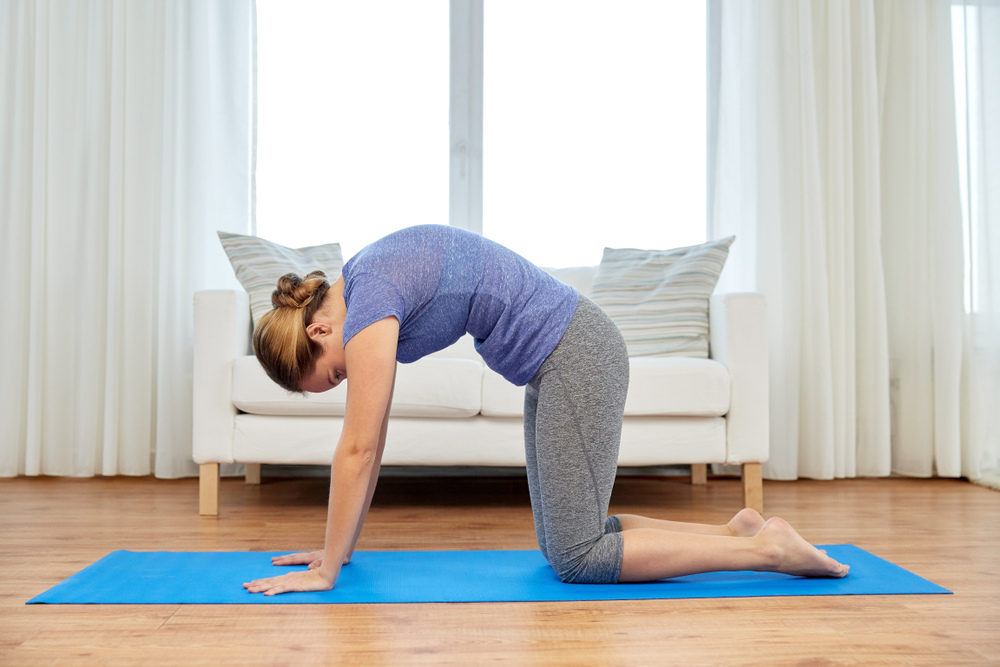
- Begin in a tabletop position with your knees and palms flat on the ground.
- Inhale as you arch your back, dropping your belly towards the floor, and lifting your head and tailbone (Cow Pose).
- Exhale as you round your back, tuck your chin to your chest, and engage your abdominal muscles (Cat Pose).
- Repeat this flowing movement for several breaths.
3. Pigeon Pose (Eka Pada Rajakapotasana)
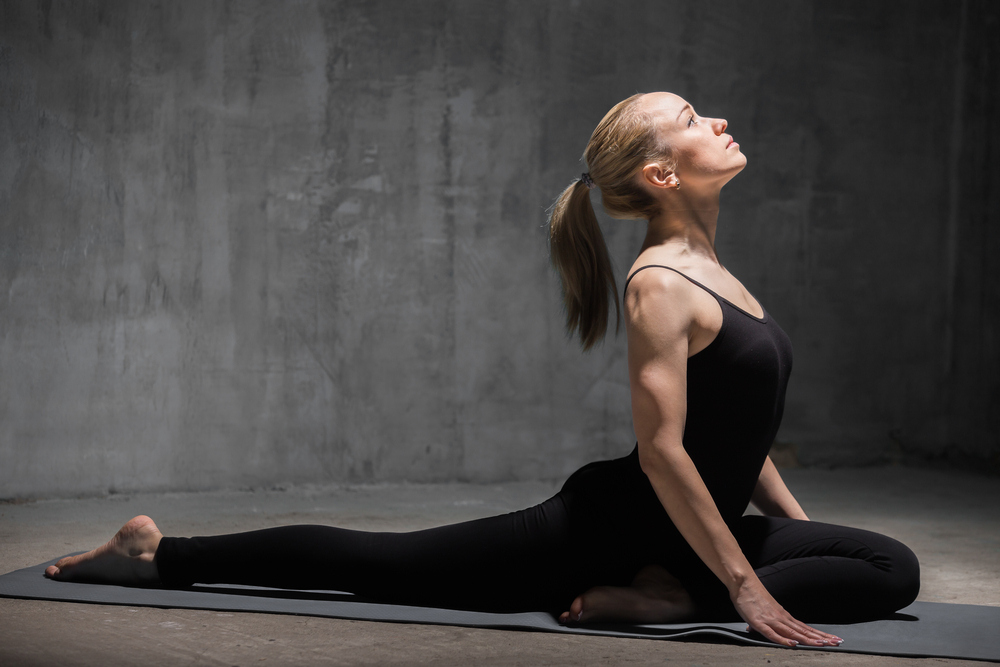
- From the tabletop, bring your left knee forward towards the left wrist.
- Extend the right leg straight back behind you.
- Lower your chest towards the mat, supporting yourself on your hands or using props for comfort.
- Go back to the original position and repeat the same on your right side.
4. Downward-Facing Dog (Adho Mukha Svanasana)

- Start on your hands and knees, tuck your toes, and lift your hips toward the ceiling.
- Keep a slight bend in your knees, and try to press your heels toward the floor.
- Lengthen your spine, reaching your tailbone towards the ceiling, and feel the stretch on your lumbar muscles.
5. Extended Triangle Pose (Utthita Trikonasana)
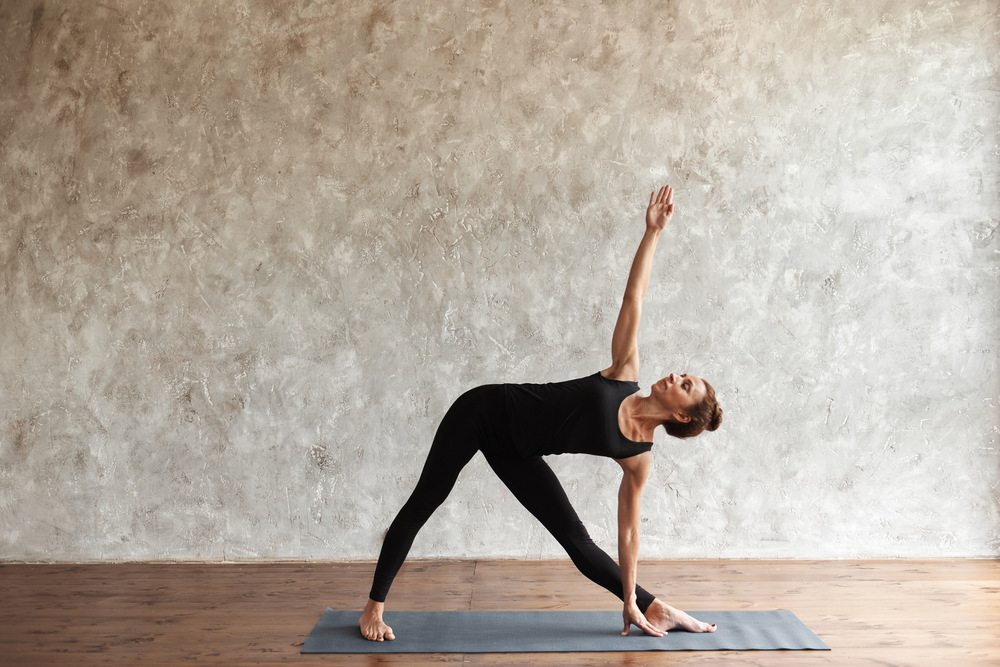
- Stand in a neutral position with your feet wide apart.
- Turn one foot out and extend your torso to the side, reaching your hand down to your shin or the floor.
- Extend the opposite arm upward, creating a straight line from the fingertips to the extended foot.
6. Cow Face Pose (Gomukhasana)
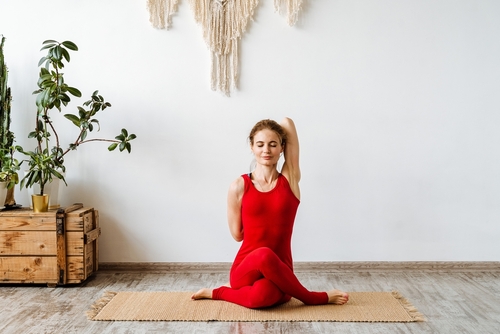
- Start in the seated position with your legs crossed.
- Bring one arm overhead, bend the elbow, and reach the hand down your back.
- Use the other hand to reach up your back from behind, attempting to clasp fingers or hold a strap.
7. Seated Forward Bend (Paschimottanasana)
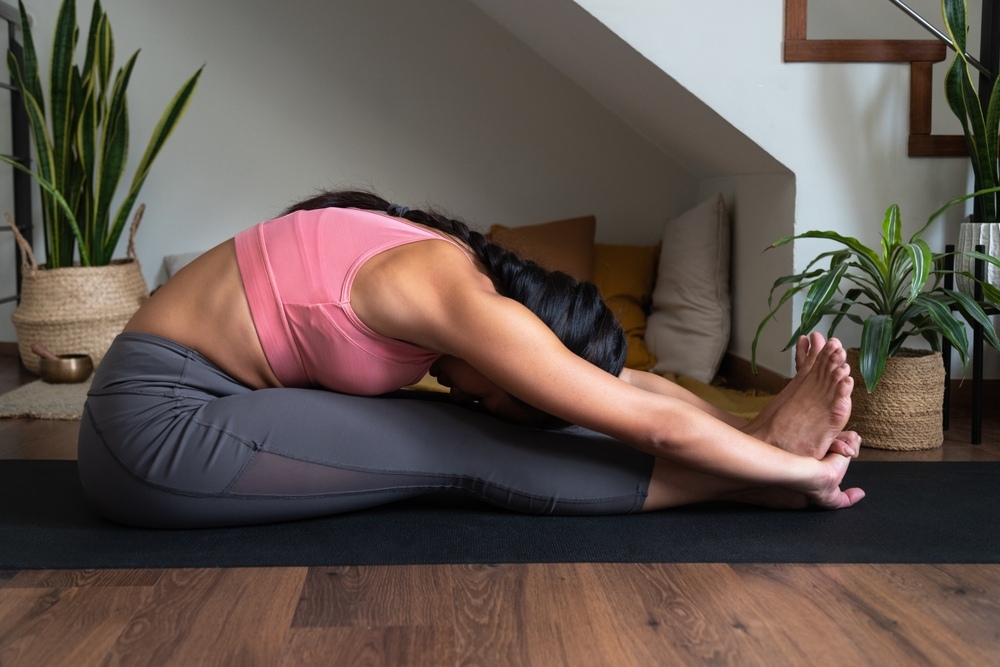
- Sit with your legs extended in front of you.
- Inhale to lengthen your spine, then exhale to fold forward from the hips.
- Reach towards your feet, keeping your back straight.
- Hold and then go back to the initial position.
8. Bridge Pose (Setu Bandhasana)
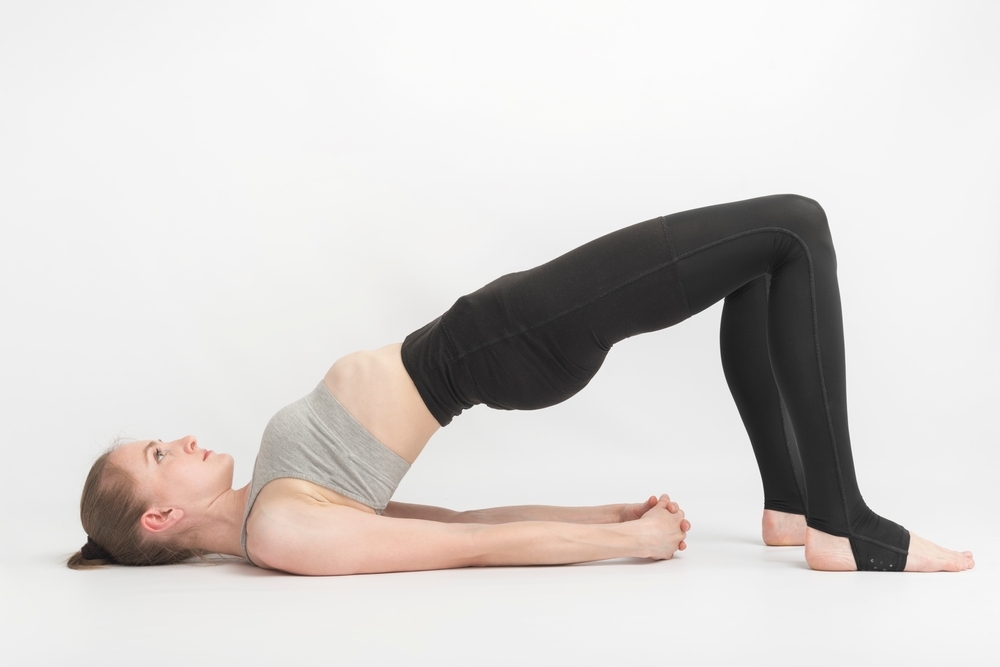
- Lie on your back with knees bent and feet hip-width apart.
- Inhale, press through your feet, and lift your hips towards the ceiling.
- Clasp your hands under your back and roll your shoulders underneath you.
9. Reclining Hand-to-Big-Toe Pose (Supta Padangusthasana)
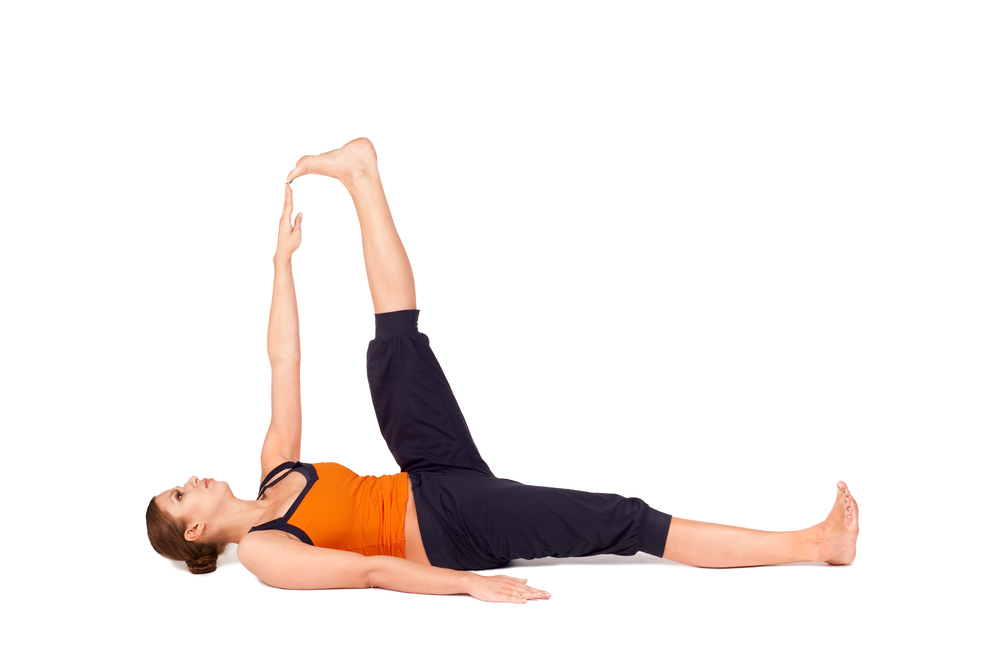
- Lie on your back, extend one leg upward, and hold the big toe with your hand.
- Keep the other leg bent or extended on the mat.
- Use a strap if needed to reach the big toe comfortably.
10. Supported Fish Pose
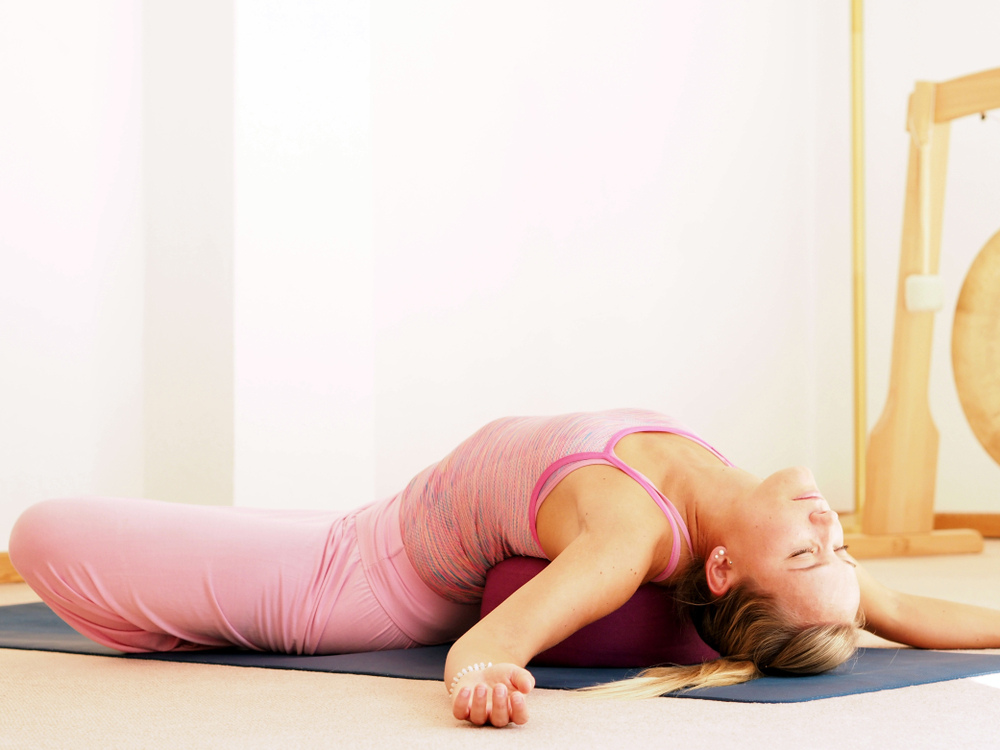
- Place a yoga block or cushion horizontally under your mid-back while lying on your back.
- Allow your chest to open, supporting the natural curve of your spine.
- Relax in this gentle backbend, keeping your head supported on the mat.
Although these may be effective, one must visit a physical therapist and undergo medical treatments if the symptoms do not subside over time.
Safety Tips to Keep in Mind While Practicing Yoga for Sciatica
Since sciatica is a chronic condition that occurs due to bad posture, following wrong instructions, overdoing, or not following precautionary measures may be counterproductive. Therefore, to stay away from further pain and distress, you must follow certain safety tips such as:
- Before starting any yoga therapy for sciatica, consult with a healthcare professional to ensure it is safe and appropriate for your specific condition, especially if you have serious symptoms or have undertaken physical therapy.
- Opt for a qualified yoga instructor with experience in working with individuals with sciatica or other similar conditions.
- Inform your yoga teacher about your sciatica condition, including the severity of the pain and any specific movements or positions that aggravate it.
- Begin with gentle and basic yoga poses. Avoid pushing yourself too hard, especially in the beginning.
- Pay close attention to proper alignment in each pose to avoid unnecessary strain on the sciatic nerve and affected muscles or on your neck muscles.
- Do not force your body into deep stretches. Overstretching can exacerbate sciatic pain; instead, focus on gradual and controlled movements.
- Modify poses to suit your comfort level. Use props, such as blocks or cushions, to support your body and reduce strain.
- Be cautious with forward-bending poses as they can compress the sciatic nerve; consider gentler variations or skip these poses.
- Include sciatica-specific stretches like pigeon pose, reclining hand-to-big-toe pose, and seated forward bends with caution and proper modifications.
- If a pose causes pain or discomfort, stop immediately. It's crucial to listen to your body and not push beyond your limits.
- Incorporate mindful breathing to enhance relaxation and reduce tension in the body. Controlled deep breaths can help manage sciatic pain.
- Adequate hydration is essential to maintain the health of spinal discs and surrounding tissues. Drink enough water before and after your yoga session.
- Consistency in your yoga practice can bring long-term benefits. However, it's essential to balance regular practice with proper rest and recovery.
- Skip high-impact poses or activities that involve jumping or sudden movements, as these can strain the lower back and aggravate sciatic pain.
Conclusion
Yoga for sciatica is an effective direction toward finding long-term solutions for your symptoms and enhancing your quality of life. The suitable yoga poses help reduce physical symptoms through stretching, increasing flexibility, and enhancing balanced muscle management. They also help with better emotional and cognitive regulation and help endure the pain by increasing patience, concentration, and relaxation. Unlike over-the-counter pain relievers, yoga does not have any side effects. Moreover, these poses are very easy and effective. However, while performing these poses, one must be extremely careful and follow the safety tips that have been discussed to prevent further injuries or long-term side effects.
ALSO READ: Wondering How to Lose Calf Fat? Here Are 13 Simple Exercises That Might Help.





 JOIN OUR WHATSAPP CHANNEL
JOIN OUR WHATSAPP CHANNEL
































































































